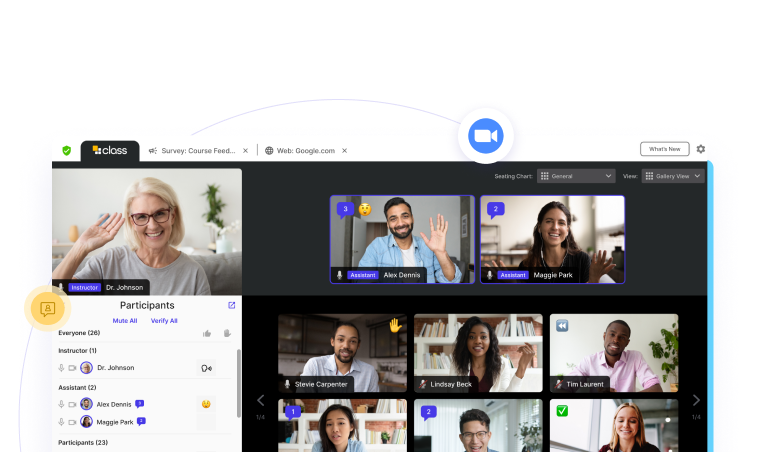
Mike Lovell is the SVP of Marketing at Class. He has dedicated his career to technology and the applications that can innovate the way people live and learn.

Mike Lovell is the SVP of Marketing at Class. He has dedicated his career to technology and the applications that can innovate the way people live and learn.

As virtual instructor-led training (VILT) becomes more prevalent and more critical to organizational success, one thing is clear: not all virtual training environments are created equal. For VILT to deliver meaningful outcomes, the platform matters. This blog—informed by findings from a recent study conducted by Training magazine in partnership with Microsoft and Class—explores what sets a virtual classroom apart from generic video conferencing tools and why investing in the right infrastructure pays off.
“The best practice is to consider using a virtual classroom that is designed for learning and development, not just a video platform or video conferencing platform for calls,” says Lorri Freifeld, editor and publisher of Training magazine. “[A virtual classroom] can help you integrate assessments and analytics. There's built-in tools that can help you track participation. You can test knowledge. You can measure the engagement in real-time.”
Too many organizations are still trying to force-fit meeting tools into training use cases, and it shows. These platforms may support basic communication, but they lack the specialized features that make training stick. The result? Missed engagement opportunities, limited instructor insight, and passive learning.
A dedicated, purpose-built virtual classroom changes that. It empowers instructors with tools designed specifically for learning: engagement tracking, assessment integration, breakout room enhancements, and more.
The research found that 73% of respondents use Microsoft Teams as their primary VILT platform, followed by 52% using Zoom. While popular, these tools weren’t created with instructional design in mind, leaving a clear opportunity for purpose-built alternatives.
To build a virtual training experience that actually moves the needle, you need more than a workaround. Trying to retrofit a general-purpose video conferencing tool into a virtual classroom often leads to poor learner engagement and a loss of valuable data. Instead, choose a platform that prioritizes interactivity, insight, and flexibility.
As Freifeld puts it, “[Purpose-built virtual classroom] platforms can enable that structured collaboration, role-based interactions, and instructor monitoring.”
When your platform can track participation, test knowledge, and measure engagement in real time, you unlock a new level of insight. Data becomes a tool that can help you fine-tune your training and demonstrate tangible business impact.
Organizations focused on upskilling, onboarding, or leadership development can use these insights to track growth, identify gaps, and continuously improve outcomes.
Breakout rooms are a cornerstone of interactive virtual learning. But if your platform makes them clunky to set up or hard to manage, engagement suffers. Built-in breakout room functionality in a virtual classroom streamlines group collaboration and enables real-time oversight.
“Enhance [your] breakout room functionality,” says Freifeld. “Nothing is more frustrating than when you’re not able to use breakout rooms. When you’ve had trouble creating breakout rooms or creating breakout rooms and then having people come back into the general session, it limits engagement.”
This kind of friction adds up. The right tool removes barriers so learners and instructors can focus on what matters: connection, content, and knowledge retention.
Your learning management system (LMS) is the backbone of your training program. So whatever virtual classroom you choose, it must integrate seamlessly with your LMS. This ensures accurate tracking, unified reporting, and a frictionless user experience.
Freifeld underscores the importance: “It's very, very important to make sure that whatever platform you decide on, that it is compatible with your learning management system. You want to be able to seamlessly track and report on your attendance and your engagement and your outcomes. You need to make sure that all of [that data] connects and that you're going to get the support that you need from the platform to make sure that that compatibility happens.”
Volvo Trucks North America faced challenges in replicating the hands-on, collaborative nature of in-person training in a virtual setting. They attempted to reimagine video conferencing tools as a virtual classroom platform, but the engaging experience just wasn’t there. After turning to Class’s purpose-built virtual classroom platform, the team was able to reintroduce elements of the in-person training experience, while also taking advantage of robust features that went beyond even the in-person experience, including deep analytical insights and interactive recordings.
Additionally, Volvo gained back productivity hours by automating processes and leveraging Class's LMS integration with Cornerstone. As Scott Behe, Senior Manager of Operations for Volvo, puts it, “Templates—and the LMS integration—are very important to our team. That ability to deliver a consistent experience is great...It’s hard to measure, but at the end of the year, we gain hours and hours of productivity.”
When you invest in the right virtual classroom, everything changes. You gain access to real-time data, deeper engagement tools, and seamless integration—all of which lead to better outcomes for learners and your organization. Instead of stretching a meeting tool to fit your needs, choose a platform purpose-built for virtual learning.
Ready to make the shift? Connect with the Class team to learn how our virtual classroom can transform your training programs. Want to dive deeper into the Training magazine study? Watch the full webinar here.

Mike Lovell is the SVP of Marketing at Class. He has dedicated his career to technology and the applications that can innovate the way people live and learn.

Mike Lovell is the SVP of Marketing at Class. He has dedicated his career to technology and the applications that can innovate the way people live and learn.
Get our insights, tips, and best practices delivered to your inbox

Sign up for a product demo today to learn how Class’s virtual classroom powers digital transformation at your organization.

Features
Products
Integrations